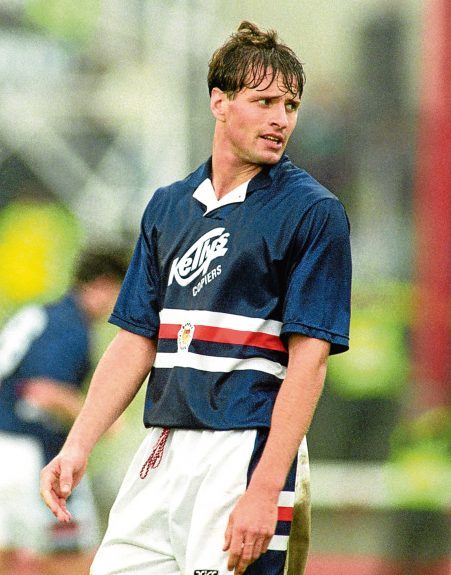Praiseworthy and impressive as Sunday’s victory was, there is no question Dundee’s last Dens Park success against Rangers was more dramatic.
And the famous 4-3 success on August 15, 1992, over a Gers side who at the time were all-conquering in the domestic game, even included what was arguably the first example of a “magic hat” in Scottish football.
Such was the strength of the Ibrox men at the time, the then newly-promoted Dark Blues’ win went down as a major shock.
Even so, the game is remembered as much for flamboyant Dee boss Simon Stainrod’s wearing of a fedora in the home technical area than the remarkable game that unfolded on the pitch.
A quarter of a century on, the Tele can reveal that magic hat Simon became famous for wasn’t even his.
It belonged to Jim Duffy, then his assistant-player manager, who was at the heart of the home defence that day.
On an August afternoon when the weather was more autumn than summer, the English gaffer grabbed the hat from their office to keep the rain off.
With the fedora on his head and wearing a flashy light raincoat, he cut a dashing figure in the dugout and, on the day, his team’s display was almost as eye-catching. So were some of the names in his line-up.
Bankrolled by Canadian millionaire Ron Dixon, as well as some solid Scottish pros the starting XI included the nation’s former international No 1 Jim Leighton in goal, Everton and Wales great Kevin Ratcliffe was making his debut and ex-England international and Arsenal midfielder Graham Rix was also in there.
There was a famous name up front in the shape of Ian Gilzean, son of Dens legend Alan, who partnered a young Billy Dodds in attack.
The Rangers side included star men like Richard Gough, Ally McCoist and big-money signing Alexei Mikhailitchenko.
For all the big names, it was Dodds, Gilzean and a little-known Dutchman who’d originally only come to Scotland to study, that would have the major influence on the outcome.
He was Ivo den Bieman, signed as a winger-cum-striker over the summer after impressing against Dundee for relegated Montrose in the First Division during the previous campaign.
A bit-part player at Dens, Den Bieman would later forge a career with Dunfermline but as a right-back.
Playing further forward, he shocked Rangers by opening the scoring and, after Ally McCoist had levelled, Gilzean fired home. Again, though, McCoist levelled. Dodds took over after the break and fired Dundee ahead for a third time. This time they were pegged back by an Ian Ferguson effort.
It seemed Rangers would go on to chalk up their expected win but Stainrod’s team were not to be denied. Gough fouled Gilzean in the box and Dodds scored from the penalty spot.
And so a memorable day was completed, though few who witnessed it could have imagined having to wait 25 years for the next Dens success.
At the time it wasn’t just a big success because of the calibre of the opposition.
In their first season back in the top flight after two in the First Division, Dundee had made a sticky start, losing their opener at home to Falkirk and then drawing with St Johnstone and Airdrie.
Their struggles continued for a while after that and four defeats, one of them against Celtic in the League Cup, on the bounce followed that first win of the league campaign.
Ultimately, though, Stainrod’s cosmopolitan team would do enough over the course of the season to retain their Premier League place.

